The ASUS Zenbook UX305 Review
by Brett Howse on March 25, 2015 8:00 AM ESTDisplay
The UX305 comes with two display options. The base model is a 13.3 inch 1920x1080 IPS display, and no touch available. The display has a matte finish to it, which helps with glare. ASUS will also be offering a 3200x1800 Plane-to-Line Switching (PLS) model with a matte finish, and that model should be available in April or so. Optionally, both models can be equipped with touch.
The model that we received is the 1920x1080 version, and the display is from AU Optronics and is model AUO212D. At 166 pixels per inch, it is a good resolution for this size of display. It is a full RGB stripe, which is pretty typical for this resolution and size panel.
The anti-glare coating causes the sub-pixel distortion seen on this image. The AU display is a 6-bit model, but that is unsurprising given the low cost of this device. As an IPS display, it has great viewing angles and is a big step up over the TN panels that you may still find at this level of cost.
To test the display accuracy and its ability to reproduce color, we use SpectralCal’s CalMAN 5 software suite, with an X-Rite i1Display Pro colorimeter for brightness and contrast readings, and the X-Rite i1Pro spectrophotometer for color accuracy.
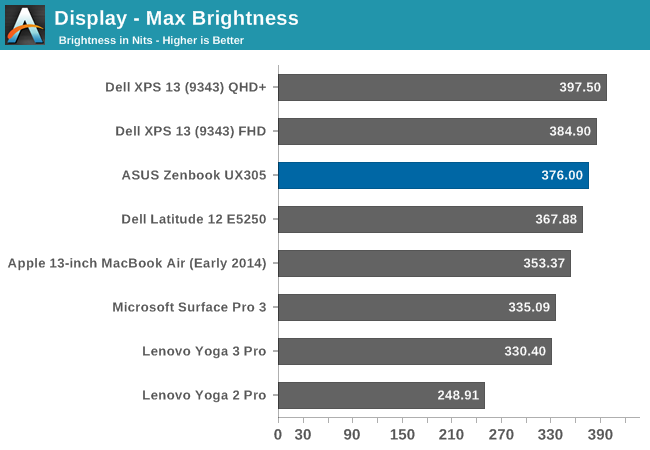
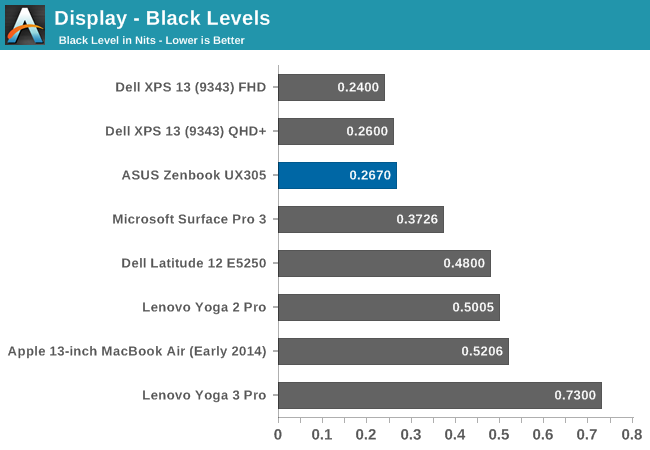
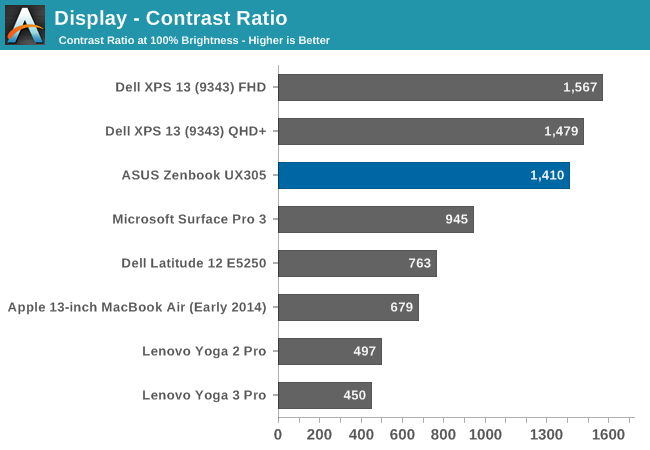
The maximum brightness for the UX305 is an impressive 376 nits. This combined with the anti-glare coating should make this a great laptop for any sort of bright room, or even outside. Even better, the panel has excellent black levels. ASUS rates the display for a contrast ratio of 500:1, but the model we received blew past that for a 1410:1 ratio which is fantastic.
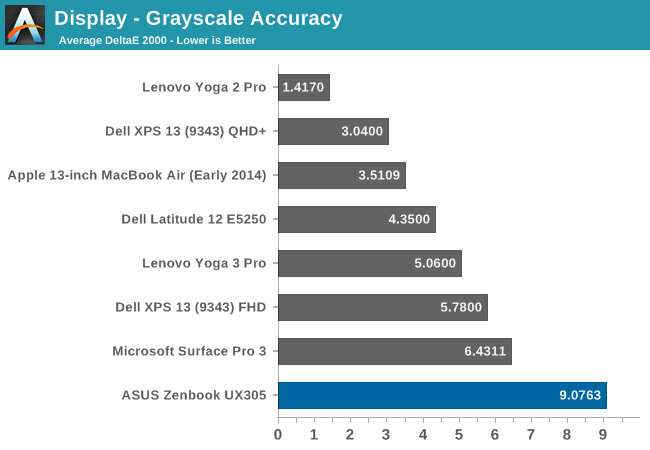
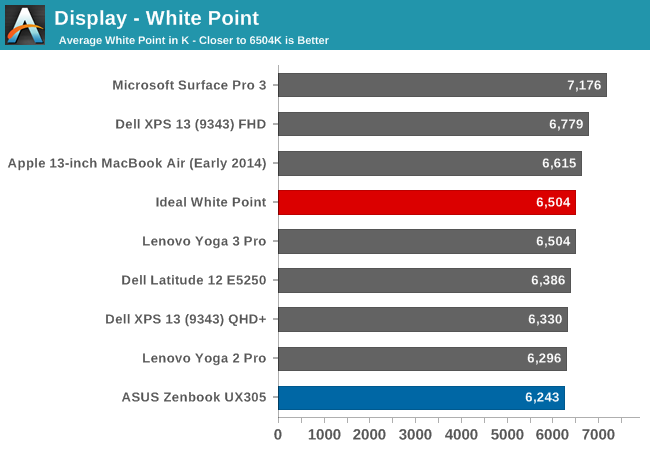
Unfortunately the great brightness and contrast is about where this display ends. The grayscale average is actually flattering the ASUS with a score of just over 9, because the error rate is between 12 and 13 from 70% brightness on. These are huge errors, since anything over 5 is a poor result, and really we are aiming for scores under three. The white point is off, and there is a huge green shift in the display by default.
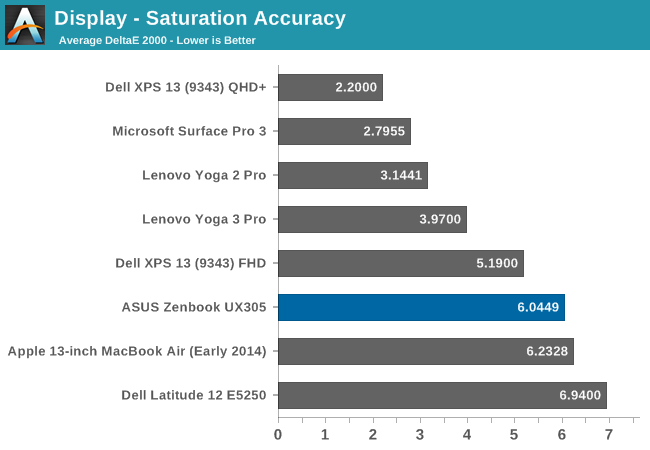
The saturation sweeps are not quite as bad as the grayscale, with the UX305 coming in just over 6. It is oversaturated on blue, undersaturated on red, and there is a green shift which pulls the yellows and teals off of their axis.
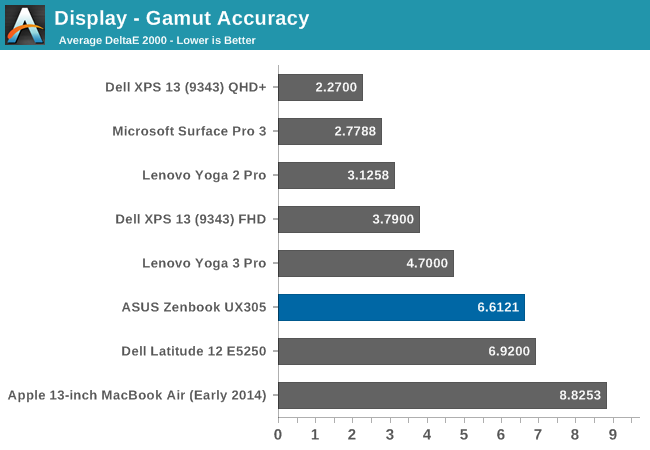
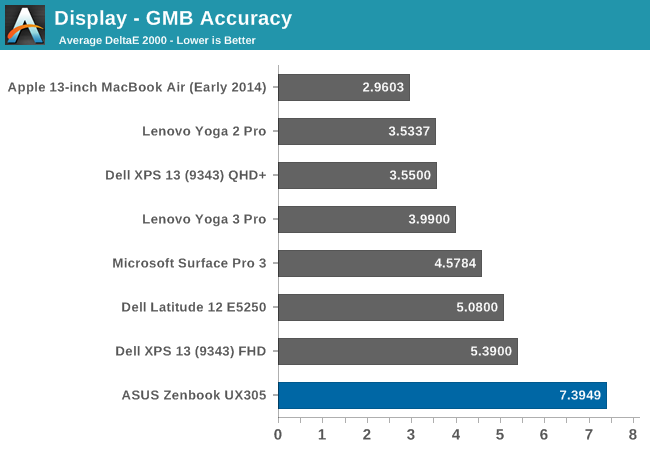
The GMB test is a more comprehensive test, and it scores very poorly again with a score over seven. The worst offenders were of course the white levels, which are very off, and the flesh tones on this display all had errors way over many of the other colors.
This is a very poor result and throws us back several years in terms of calibration. As far as out of the box performance goes the display can hit the entire sRGB colorspace, and as an IPS display it has great viewing angles, but otherwise there is nothing good to be said about this display as far as out of the box color accuracy goes.
To see if the display can be improved on with aftermarket calibration, I have run the display through our calibration software to try to fix some of the errors we encountered. Generally icc profiles will only really have a major effect on the grayscale, but that is the worst part of this display so hopefully we will be able to fix some of these issues.
Once calibrated, the display is almost completely different. There is still a large error on 100% white, but the overall grayscale drops to 0.9582, with a bit too much green but it is barely noticeable on most levels. The gamut drops to just 3.1256, saturation plummets to 1.9571, and the GMB test comes in at 2.3099.
If ASUS would take the time to include an icc profile for this display from the factory, it would be a lot better. It is amazing to me that ASUS would ship this display with it so far out of calibration, especially when calibrated it is almost perfect. Yes, the $699 price point is a factor, but the hard work was already done in getting a display that can produce these numbers. The easy part is taking the time to make it do that.


















164 Comments
View All Comments
Calista - Wednesday, March 25, 2015 - link
Well, for a lot of people a Core 2 Duo is more than powerful enough. Using a M4400 with a Core 2 Duo T9600 from time to time rarely does it feel slow for "normal usage", i.e. browsing the web, working with Photoshop and whatnot.Once we have reached a certain threshold more performance just doesn't seem so important any more. I would say most folks reached that threshold with the release of the later C2D CPU:s.
FlushedBubblyJock - Wednesday, March 25, 2015 - link
I know many of these people, and replacing the spindle drive with a small SSD (and my usual optimizations in 5 mins) settles it entirely for them.It's faster than the new regulars at the stores.
TheWrongChristian - Thursday, March 26, 2015 - link
I just "upgraded" from my Core Duo T2400 based laptop (which kept up with modern software) to a $60 second hand thinkpad t61, with Core 2 T7100 CPU (which easily keeps up with modern software.)I only upgraded because the screen backlight on the old laptop was a bit flaky, and only upgraded to the thinkpad because it has a fantastic keyboard and I already had the ultrabay HDD adaptor from a previous work laptop, as well as using the same PSU as my old laptop (also a Lenovo.)
Modern machines are let down by their crappy keyboards and screens. That's where the race to the bottom has hit.
TL;DR
I concur. With the push of software down to tablet and smartphones, people have learned to somewhat optimize again, and CPUs performance from ~7-8 years ago is perfactly adequate.
akdj - Saturday, March 28, 2015 - link
Except I'd argue your two biggest concerns (keyboard and screen) are ..at least ½ of the equation ... Of MUCH higher quality, legibility, brightness, contrast, and their corresponding technologies behind them; AMOLED or LCS have come leaps and bounds in the last half to full decade. I'm also intrigued by the new keyboard and trackpad Apple has implementedIf anything, it does seem more Window's OEMs are getting trackpads correct. I can't speak to their keyboards but I've been using solely OS X laptops during that time period you're talking about. Though, during that period Apple's keyboards, again, have only gotten 'Better'. Just MHO, but not a lot of laptops are upgradable either, some 32bit even limited to 3-3.5GB of RAM & nearly impossible to get an SSD inside. That, the SSD today is the ONE differentiator and bottle neck eliminator we've seen. Not the CPU, the RAM, the display or the keyboard. GPU in some cases, sure. But going solid state and fanless without the need for AC all day...for the layman, those are HUGE wins
BrokenCrayons - Thursday, March 26, 2015 - link
I completely agree with the C2D being adequate. For me, "adequate performance" was an upgraded Dell Latitude D620 with a T2300 (1.6 GHz 32-bit dual core), 4 GB of RAM which wasn't fully utilized due to the 32-bit OS and a thing about the 945 chipset that didn't recognize more than like 3.2 GB and a 320 GB non-SSD. It was and still is just fine but the battery was bad, the screen was getting kinda flickery and one of the USB ports was damaged so I bought a used Latitude E6320 with some kind of i5 Sandy Bridge in it and it's far more than I need. While I like the fanless aspects of modern laptops, I hate the short key travel and other sacrifices made in the name of making something thin. It seems pointless and faddish to do that because the laptop still needs just as much space in a handbag or whatever since the other two dimensions aren't different. I'm sure that some people will want something like this, but I can't find a reason to care that much about the thickness. I didn't care when I had a 90 MHz Pentium laptop (which was fanless...Texas Instruments Travelmate 5130..there was a heatsink and this huge heat spreader bar under the keyboard) and I don't worry about it now.074geodude - Wednesday, March 25, 2015 - link
CPU performance wise, no you will not be upgrading.But everything else - screen quality, resolution, thickness, weight, 8 GB RAM, 256 GB SSD, battery life (11+hours, try getting that out of a Core 2 Duo).
It's time to upgrade.
beehofer - Thursday, March 26, 2015 - link
The Core M might not stand much a of chance against the the U but they seem to have a purpose. I would very much like a review of the new more powerful Asus UX303LA which is sporting the 5200U. I got it from the microsoft store for 1300$ after adding a 1TB EVO 850 SSD. the screen is higher ppi than the newest 13 inch macbook pro retina with 8GB of Ram. You can't beat the bang for the buck. Battery life is the only disappointment so far.sonicmerlin - Monday, March 30, 2015 - link
Even the iPad Air 2 has a faster GPU than Core M.FwFred - Monday, June 15, 2015 - link
I'd say the GPUs trade blows, but the Core M has faster CPU, and the Asus has far more storage for an equivalent price.Novacius - Wednesday, March 25, 2015 - link
It's a shame that it hasn't keyboard backlighting and such a poor display calibration. Maybe they'll do better in future iterations. I'm very interested in a Skylake model.